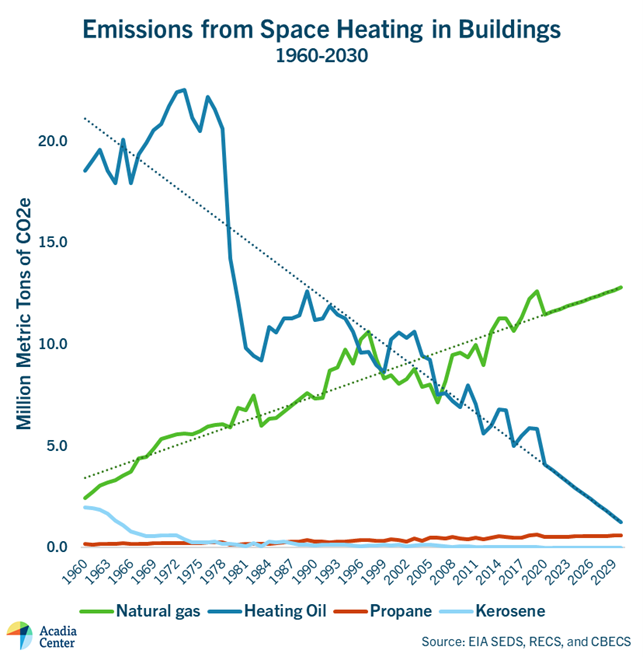APRIL FOOL’S GOLD: Acadia Center Responds to Latest Fossil Fuel Interest Attacks on Clean Energy Policies in New England
MEDIA CONTACT:
Kyle Murray
Director, State Program Implementation
kmurray@acadiacenter.org, 617-742-0054 ext.106
No, it’s not an April Fool’s Day prank: following their easily debunked November energy cost report, fossil fuel-interest think tanks are back with a new round of the same tired and misguided attacks against clean energy policies in New England. Today, the groups – including Americans for Prosperity, the Josiah Bartlet Center for Public Policy, the National Federation of Independent Businesses, the Maine Policy Institute, Massachusetts Fiscal Alliance, and Rhode Island Center for Freedom and Prosperity – held an online press conference to discuss “the effects of alternative energy mandates on the region’s taxpayers.” Since their last flawed analyses, New Englanders have endured a cold and costly winter when it comes to energy bills. The tally of these costs lays bare the region’s untenable overreliance on fossil fuels, with rising energy burdens driven by natural gas infrastructure, generous utility profits, and the region’s continued fossil fuel investments – all exacerbated by reckless actions from the Trump Administration.
With the costs of New England’s fossil fuel reliance growing, clean energy and energy efficiency now have the potential to deliver even greater benefits to families and businesses across the region, by mitigating and avoiding precisely the kind of price spikes seen this winter. New England wholesale electricity costs exceeded $10 billion in 2024 for the third time in four years, a period that saw natural gas grow to unprecedented levels of overreliance (51% of net energy for load in 2024). One program giving payments to dual-fuel (gas-oil) power plants, the inventoried energy program (IEP), cost ratepayers almost $80 million over just five days this winter. And gas heating customers felt the pain too, with natural gas spiking to an average of almost $17/MMBtu in the month of January (a 120% increase over the prior January), and the region’s growing gas distribution networks pushing up delivery costs to previously unseen levels. Energy efficiency programs like Mass Save, touted as the Boogeyman for rising costs, are actually saving customers money by preventing needless additional expenditures on fossil fuels at such costly rates. For example, Rhode Island’s 2024-2026 energy efficiency plan is helping avoid almost $50m in added costs if load was instead met by purchasing additional electric supply.
Figure 1 and 2: New England Wholesale Electricity Costs and Sources of Grid Electricity (source: ISO-NE)
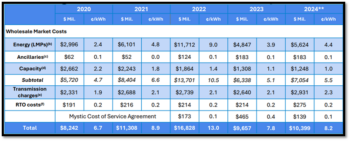
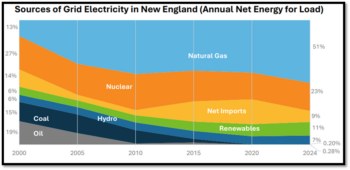
The takeaway for the region remains true: New England has a once-in-a-generation opportunity to redesign and revolutionize its energy system with clean energy and localize the job-creation and GDP impact of energy expenditures within the regional economy, rather than export them afar. Right now, the region has almost all its eggs in the fossil fuel basket, and this offers only the false promise of fool’s gold in protecting the region’s consumers from rising energy bills. The region must double down on its climate and clean energy goals to make the broader northeast region energy independent from fossil fuels, reduce consumer price spikes, and mitigate the economic harms of worsening climate change.
It’s time to set the record straight once again:
False claim #1: the region’s aggressive renewable climate energy policies are a major driver of high utility bills in New England.
Don’t let them fool you: New England spends $76b per year on energy, the majority of which still goes to fossil fuels from outside the region (source: EIA data for 2022). Plus, it was very, very cold this winter; the coldest winter since 2014-2015, in fact.[1] According to data compiled by Acadia Center (see figure 3 and 4 below), the average temperature in December 2024 was a full 10°F colder than December 2023. Further, from December 2024 through February 2025, Massachusetts saw 23 days colder than 20°F, compared to only nine such days the year prior. These colder temperatures generally mean that residents are using more energy, driving up bills.
Figures 3 and 4: Quantifying Winter 2024-2025 Cold Intensity (source: Acadia Center)
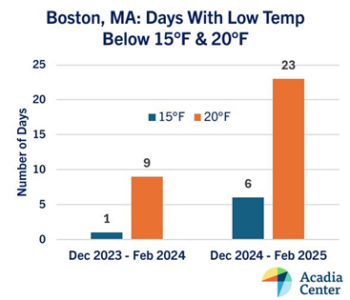
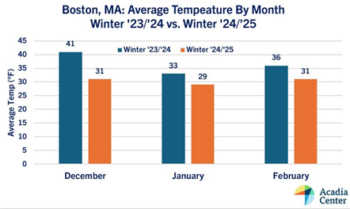
However, due to the Commonwealth’s overreliance on natural gas and other fossil fuels, it also means higher costs for the supply of energy. As America exports more liquefied natural gas (LNG) abroad, domestic gas prices are increasingly tied to the unpredictability of global gas markets, leading to increased price volatility for consumers. By contrast, renewable energy contracts provide a means of locking in affordable prices/rates over a long period of time, helping hedge and insulate the region from the volatile swings in fossil fuel commodity prices seen this winter. Had the Trump Administration not brought offshore wind development to a grinding halt, more high-value offshore wind resources would be available to mitigate winter price spikes and deliver much needed winter resource adequacy in the winters to come.
On the gas side, existing gas customers pay a disproportionate share of the costs for bringing new customers online. Since 2018, existing gas customers have footed the bill for 80% of all new gas customer connections. And these subsidies – known as line extension allowances – are driving up gas bills for everyone. In 2023 alone, Massachusetts gas customers were charged $160 million to add new customers to the gas system, to the tune of $9,000 per new customer, which is reflected on ratepayer gas bills. The cost of adding new customers is rising as well: the average cost of adding new customers rose 50% between 2020-2021 and again in 2022-2023. In fact, despite an acknowledgement by the state and by utilities that we should be winding the gas system down – not expanding it – the growth of the sprawling pipe network shows no signs of stopping. According to analysis from the Attorney General’s Office in Massachusetts, the path we’re currently on could see the state’s gas rate base – the total value of gas system assets on which utilities are allowed to earn a rate of return – jump from $10 to $20 billion in the span of roughly a decade, when factoring in the cost of new and replaced gas pipes.
Figure 5: Analysis of Growth Trajectory for Gas System Rate Base in MA (source: Joint Direct Testimony of Brattle Group on behalf of the MA Attorney General’s Office, DPU 24-GSEP-01, Feb. 2025)
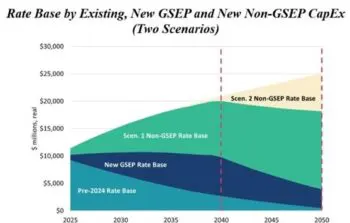
False claim #2: state laws requiring net zero by 2050, which are driving up costs for families and businesses.
As we wrote back in November, extensive modeling previously conducted by Massachusetts for the Commonwealth’s ‘2050 Decarbonization Roadmap’ and Clean Energy and Climate Plans (CECP) provide evidence for a much different trajectory for regional energy prices tied to achievement of 2050 climate targets. These studies included granular region-wide energy system modeling to arrive at their results for Massachusetts customers:
- The 2025/2030 CECP found: “The increased adoption of electrified transportation and heating systems means that the average Massachusetts household will spend less money on energy every year. Average overall household energy expenditures, which include transportation-related fuel costs (included as “energy” cost in this analysis), are projected to decline 8% by 2030 relative to 2019 levels, for an average household savings of $400 per year.”
- The 2050 CECP found: “the efficiency gains of electrification will result in lower household energy expenditures through 2050 (monthly bills for electricity and fuels). Transportation and household-related electricity and fuel expenditures are projected to decline by roughly 13% between 2030 and 2050, representing an average of nearly $600 (in 2021 dollars) in 2050 compared to 2030.
We also have to remember: pathways that invest in local energy resources, including renewable electricity generation and energy efficiency, create more jobs and demonstrate greater economic benefits by keeping money local compared to pathways more reliant on imported energy. For example, the “All Options” pathway from the Massachusetts 2050 Decarbonization Roadmap Study Economic and Health Impacts Report (which emphasized deep electrification and broad renewable electricity buildout) had 17% higher economic “output” (the broadest measure of economic activity) in Massachusetts per dollar invested than the “Pipeline Gas” pathway (which relied heavily on imported alternative fuels). Evidence of these benefits in action is highlighted throughout state clean energy industry reports conducted regularly, such as in Massachusetts, where in 2022, the industry contributed over $14b to Gross State Product, and in Maine, where the clean energy economy now accounts for over 2% of the state’s total workforce, more than 15,000 jobs.
False claim #3: energy efficiency programs are the culprit for rising energy bills this winter.
In response to complaints about energy affordability, some have blamed increased funding of the region’s cost-effective energy efficiency programs. This is no small source of irony – Mass Save®, for example, is a relatively small fraction of bills, but it is the most potent tool available to empower consumers to control their energy costs and protect them from fossil fuel price spikes. The vast majority of the bill for gas customers, around 70-75%, goes toward natural gas costs – relating to gas supply, distribution, and maintenance, compared to just 15-25% going toward energy efficiency. A similar dynamic is true on the electric side, where energy efficiency programs also represent only a small fraction in bills compared to fossil fuel and poles/wires costs: based on a recent bill from an Acadia Center staffer in Massachusetts, efficiency accounts for around 9% of a total National Grid electric bill.
Figure 6: Breakdown of Monthly Gas Bill for Massachusetts Customer in February (source: Eversource)
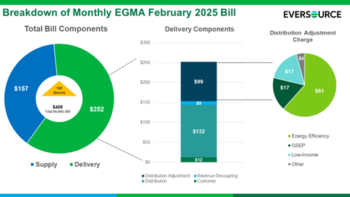
Unlike other energy costs, efficiency is the only investment that is required to pass cost-effectiveness testing. In fact, overall system costs would be billions of dollars greater without the cost reductions secured with efficiency; the more the benefits of improved energy efficiency are reduced, the costlier our energy system becomes.
Figure 7: Benefits of Current Three-Year Energy Efficiency Plans by State (source: Acadia Center)
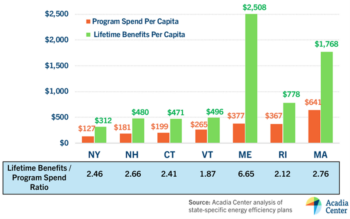
We should be investing even more to give homeowners, renters, and small businesses more tools to control their energy use and utility bills by increasing access to energy efficiency and implementing time-of-use (TOU) rates, plus expanding offerings for demand response and battery storage – which serve as far more cost-effective solutions for peak demand periods than the enormously costly reliability-must-run (RMR) contracts with fossil fuel power plants that ratepayers have had to bear in recent years. Increased oversight and accountability of utility distribution costs can also help drive savings for ratepayers, including via performance-based regulatory approaches to reduce inefficiencies and align incentives.
Looking back over time, the enormous benefits of the region’s energy efficiency benefits are self-evident. They have provided, as recently as 2023, 15% of gross electricity load for the entire region over the course of the year. In this way, energy efficiency helps meet the energy needs of our grid much in the same way as traditional supply resources like gas, oil, and coal. At the end of the day, the lowest-cost source of electricity is the one we never use.
Figure 8: Historic Benefits of NE Energy Efficiency Programs, 2012-2023 (source: Acadia Center)
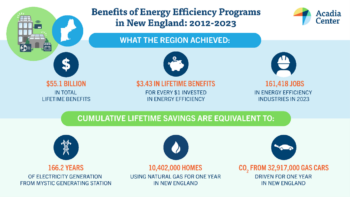
[1] https://www.nbcboston.com/weather/stories-weather/boston-total-snowfall-this-winter/3636399/
Myth Busters!
We’ve all had the experience of reading a news article, blog or social media post and thinking: “But that’s wrong!” or “This is misinterpreting and misusing the research!” Acadia Center would like to set the record straight on some of the common misconceptions about clean energy and energy efficiency.
Myth: 100% clean energy is a pipedream, and we will always need oil, natural gas, and other fossil fuels.
Reality: It’s not a question of “if” the world can run on 100% clean energy, but “when.” Renewable electricity is expected to grow globally by 1,200 gigawatts in the next five years, the equivalent of the total electricity capacity of the U.S. By 2050, many countries will achieve 100% renewable energy, and many countries can meet their energy needs with 100% clean energy. It is feasible around the world AND here in the Northeast.
Myth: Renewable energy is too expensive.
Reality: Renewable energy resources are increasingly cost-competitive compared to fossil fuels and getting more so every day; in fact, solar and wind energy are cheaper than gas power plants in many situations. In addition, it is cheaper to build new renewables – without subsidies – than it is to keep existing coal plants running. The costs of renewable energy keep decreasing, while the cost of aging fossil fuel resources keep increasing, and that’s all before you even factor in the social cost of carbon.
Myth: Energy efficiency is a limited resource because we’ve already made most efficiency gains.
Reality: Energy efficiency is a vast resource that can include everything from huge industrial plants to the elevators in your office building to the toaster on your kitchen counter. We have massive untapped energy efficiency gains yet to come, as well as energy efficiency resources that can be turned on and off, or up and down, to satisfy demand and ensure reliability during extreme events like heat waves.
Myth: Clean energy and energy efficiency only help the wealthy.
Reality: Everyone benefits when we deploy clean energy resources, because the cost of the energy is reduced. Many low- and moderate-income households live in homes that are much less efficient than average, so targeting clean energy and efficiency work in those places make a huge difference in families’ household budgets. Clean energy helps to eliminate local air pollution, which disproportionately harms low-income communities and communities of color.
Myth: Heat pumps are not cost-effective.
Reality: Whole-home electrification that includes heat pump installations can save energy and money, especially when paired with common-sense weatherization improvements such as better insulation. Further, electricity rates are somewhat sheltered from the wild fluctuations seen in natural gas prices. This winter residents could suffer the most expensive gas prices in years, but as more renewables are added to our grid, electricity prices can remain stable even when gas prices climb. Best of all, heat pumps help avoid the increasing cost and health impacts associated with greenhouse gas emissions, helping to create the clean energy future all deserve.
Unfortunately, misconceptions of this kind continue in our work, so we’ll continue to counter fiction with facts. Watch for more “Myth Busters” coming soon!
Baker Administration’s Energy Bill Attempts to Harness Winds of Fortune
On October 13th, Massachusetts Governor Charlie Baker filed legislation that he hopes will provide a massive boost to clean energy in the Commonwealth. The legislation contains a number of reforms to the offshore wind procurement process, but centers primarily around the creation of a new Clean Energy Investment Fund. Located at MassCEC, this fund will be financed with $750 million in COVID-19 funds from the American Rescue Plan Act of 2021 (ARPA). The Administration hopes that this investment, the “largest investment in the clean energy economy that the Commonwealth has made to date,” will spur the development of a major industry in the state.[1] The Baker administration’s goal seems to be to repeat the success that Massachusetts has had with the life sciences industry, now with the growing clean energy sector. In 2008, then-Governor Patrick signed a $1 billion bond to fund the Massachusetts Life Sciences Center Capital Funding Programs. Thanks to that bill and repeated investments, the life sciences are one of Boston’s most successful industries.[2]
In addition to this substantial investment in clean energy, this legislation also modifies a number of provisions concerning the offshore wind procurement process, which Acadia Center considers to be largely positive. Under current state law, each new bid for long-term offshore wind contracts must be lower than the last accepted bid. Unfortunately, the first bids for offshore wind contracts came in significantly lower than expected. This has made getting each subsequent bid under the cap much more difficult, with the last round of procurement receiving only two bidders.[3] This legislation eliminates the price cap that is currently constraining the industry, which should open the field to many more bidders.
The proposed legislation also eliminates a glaring conflict of interest in the bid selection process. Under current law, the electric distribution companies (EDCs) select the winning contracts from the offshore wind developers, with no protections against the EDCs selecting a bid where they directly partnered with offshore wind developers. This legislation removes this conflict of interest by selecting the Department of Energy Resources as the final arbiter, in consultation with the EDCs. Additionally, this bill implements better flexibility for DOER in selecting a bid to give greater credit to bids that promote economic development, with a focus on diversity, equity, and inclusion; benefits to environmental justice communities; and mitigation and avoidance of detrimental environmental and socioeconomic impacts. Acadia Center welcomes these developments.
The bill is not without its deficiencies, however. Chief among Acadia Center’s concerns is the modification to remuneration from a ceiling of 2.75% to a floor of 2.5%, when it should be eliminated entirely. Under current state law, EDCs can receive up to 2.75% of the total contract price for long-term offshore wind contracts as compensation for holding the contract on its books.[4] The proposed legislation sets this payment at 2.5%.The idea when it originally passed in 2016 was that large-scale offshore wind was a brand-new industry in the United States, and the EDCs faced some uncertainty and risk under the contracts. The offshore wind industry in Massachusetts has since proven itself to be a smart investment that will pay dividends for the EDCs, even without remuneration. Remuneration for EDCs with these contracts is no longer necessary and should be eliminated completely.
The funding of the new trust fund could use improvement as well. While the infusion of $750 million will certainly help jumpstart the industry, the use of ARPA money is concerning. First, the money from ARPA is a one-time source of funding for the Commonwealth. This legislation fails to set up a recurring revenue source, and instead leaves future funding up in the air. Additionally, the money from APRA is time-limited and must be expended by December 31, 2026.[5] These factors leave the future of this new fund uncertain.
Finally, the specific purposes listed for the Fund are somewhat vague and unclear. For example, it is not currently clear if the definition of clean energy technology would include the heat pump industry for home electrification. Given that the administration’s own Clean Energy and Climate Plan calls for the installation of one million heat pumps by 2030, it would be foolish to possibly exclude the heat pump industry because of vague terminology.[6]
Overall, Acadia Center appreciates the work put into this legislation by the Baker administration. We look forward to working with them and the legislature to make this bill as strong as possible to deliver the clean energy future we all deserve.
[1] According to Governor Baker’s filing letter with the legislation: https://malegislature.gov/Bills/192/H4204
[2] See https://www.bostonglobe.com/2021/06/15/business/has-boston-become-silicon-valley-biotech/
[3] See https://commonwealthmagazine.org/energy/2-offshore-wind-developers-submit-bids/
[4] See https://commonwealthmagazine.org/energy/dpu-gives-168m-offshore-wind-bonus-to-utilities/
[5] See https://home.treasury.gov/system/files/136/SLFRPFAQ.pdf
[6] See https://www.mass.gov/doc/interim-clean-energy-and-climate-plan-for-2030-december-30-2020/download
Connecticut promoted a natural gas plan that was supposed to save taxpayers money. Natural gas prices are now soaring, promising a costly winter
In August 2014, Gov. Dannel P. Malloy, officials from the Fairfield County town of Wilton and representatives of Yankee Gas celebrated the start of a large-scale natural gas expansion project estimated to save taxpayers hundreds of thousands of dollars a year.
Malloy’s Comprehensive Energy Strategy recommended changes in energy efficiency, electricity supply, industrial energy requirements, transportation and natural gas. He promoted his plan to spur economic development, business growth and reduced costs in response to persistent complaints from homeowners and businesses about high energy prices.
A key part of the governor’s plan was to convert heating in homes and businesses to natural gas from oil, a strategy that Wilton embraced. Malloy announced in 2012 an ambitious goal of connecting 300,000 households to natural gas by 2020.
State officials reported in 2018 that 39,104 residential customers converted to natural gas for heating and 12,021 commercial and industrial customers shifted to natural gas for generation or other processes between 2014 and 2016.
But now, soaring natural gas prices are eliminating the rationale to abandon oil.
High natural gas prices promise a costly winter
In Wilton, all four of the town’s schools were hooked up to natural gas by 2016.
Local officials are now bracing for a costly winter as natural gas prices soar. Wilton has budgeted more than $500,000 for heating, up from $440,000 last year and about $300,000 before that, said Chris Burney, director of public works and facilities.
“In the next month or so we’ll decide if we have to pull money out of other areas to supplement the heating bill,” he said.
Part of the higher cost is due to fresh-air systems that run 24/7 in response to COVID-19 safety mandates. But rising natural gas prices also are responsible for the financial pain.
“I’m watching the market like everyone else,” Burney said.
Critics of the Malloy administration’s energy policies say consumers who spent thousands of dollars to convert to natural gas have little to show for their investment now that gas prices are spiking. As prices fluctuate, with gas and oil taking turns as the more expensive heating fuel, family-owned oil dealerships say that was always their point: Markets, not government, dictate commodity prices.
Gas pipeline construction has ‘not materialized’
In a February 2018 report, state energy officials said gas main installation has “not materialized at the rate the local distribution companies projected.” Utilities are not overbuilding, but are installing mains to meet current and near future customer demand, DEEP said.
In addition, with expanded use of fuel cells and other on-site power such as solar panels, “much of the anticipated residential natural gas demand” is shifting to the commercial and industrial sectors, that show greater demand, the state said.
Connecticut Natural Gas, Southern Connecticut Gas and Yankee Gas have installed about 381 miles of gas lines from 2014 to 2019, with 2020 information not yet reviewed, according to the state Public Utilities Regulatory Authority. The Malloy administration said in 2013 its goal over 10 years was to build about 900 miles of gas mains, focusing on factories, hospitals, schools and other buildings with significant energy consumption.
The Public Utilities Regulatory Authority said in December that ratepayers are on the hook for about $64 million in higher gas costs for the expansion program. Risks of the program are “demonstrably greater” for ratepayers than the utilities’ shareholders, regulators said.
Meanwhile, with natural gas prices continuing to rise, “it doesn’t make sense for customers to make the switch,” said Shannon Laun, a staff attorney at the Conservation Law Foundation, an environmental advocacy organization.
The U.S. Department of Energy reports that a natural gas bench mark in June and July was at its highest level for the same months since 2014. In the first week of October, the spot price jumped 5.7%.
The reasons include sharply higher prices in Europe due to rising demand as COVID-19 restrictions ease and less natural gas storage in the U.S. than last year due to a drop in production during the pandemic.
….
A push for electrification and weatherization
Amy McLean, Connecticut director of the Acadia Center, a clean energy advocacy group, said heat pump technology has expanded and improved over the past few years. Electrification and weatherization are common sense energy solutions and state policy should not give incentives to switch to gas, she said.
“At this point gas companies say natural gas is cleaner than oil,” McLean said. “It’s about the same or worse than oil because of leaks in pipelines.”
Read the full article in the Hartford Courant here
RGGI Centers Environmental Justice in 3rd Program Review
Environmental justice is taking center stage in the latest Regional Greenhouse Gas Initiative (RGGI) program review now underway.
…
Justice and equity considerations were among the topics that RGGI sought input on during a public engagement session for the program’s third review since its launch in 2009.
….
While RGGI has delivered many benefits, such as clean air and energy savings, “the program falls short when it comes to ensuring that those benefits are equitably delivered,” Jordan Stutt, carbon programs director at Acadia Center, said during the session.
Read the full article in RTO Insider here
Massachusetts advocates say they’re being ignored in future-of-gas talks
As Massachusetts gas companies start legally mandated investigations into their role in a clean energy future, advocates are concerned that stakeholder voices calling for aggressive decarbonization, environmental justice, and a fair transition for fossil fuel workers are being shut out at a crucial moment in the process.
While the gas companies contend they are committed to soliciting and incorporating stakeholder feedback, advocates say the utilities are failing to fully engage with their concerns. At the same time, the state has rejected advocates’ requests for increased oversight from regulators.
“It’s important for our perspective to be at the center of this and right now it feels like we’re much more of an audience,” said Debbie New, a participant in the Gas Leaks Allies coalition. “When questions about labor, equity, health, or safety are asked, we are told they will consider them later, rather than making them integral to the process.”
In June 2020, Massachusetts Attorney General Maura Healey asked the state’s department of public utilities to open an investigation into the future of the natural gas industry as the state moves toward its goal of reaching net-zero carbon emissions by 2050. The department launched the investigation in October of that year with the stated goal of developing “a regulatory and policy roadmap to guide the evolution of the gas distribution industry.”
The first step in Massachusetts’ process required the state’s gas distribution companies to hire consultants to analyze the costs, regulatory implications, and emissions reductions involved in several different decarbonization strategies the state could pursue. These studies, the order specified, should look at the so-called “pathways” laid out in the state’s 2050 Decarbonization Roadmap, as well as any other scenarios deemed appropriate. They should also take into account the input of stakeholders, the state said.
….
That timeline makes right now a very important moment for environmental and public health activists. The report that emerges from the current process will inform the rest of the discussions and decisions throughout the investigation. Therefore, advocates argue, it is essential that there is broad agreement as to the scenarios the consultants model, the data used, and the assumptions made.
“If we are relying on this study, let’s do our homework,” said Amy Boyd, director of policy for climate nonprofit the Acadia Center. “We need to ask the right questions in order to be able to trust the answers at the end of the process.”
Read the full article in Energy News Network here
Supporting Public Health, Transportation Investment and Climate Commitments through TCI-P
Connecticut, Massachusetts, and Rhode Island must not squander their opportunity to deliver the clean air and improved transportation options that residents and businesses deserve. Chronic underinvestment—both in marginalized communities and in alternatives to personal vehicles—has resulted in congested roads, inadequate public transit, and isolated communities. At the same time, the imported fossil fuels used to power vehicles remain the region’s most significant contributor to climate change and a major source of locally harmful air pollution.
Bold action is needed to address these growing challenges. One piece of the solution is the Transportation and Climate Initiative Program (TCI-P), a multi-state effort to reduce tailpipe pollution while funding investment in clean transportation projects. In southern New England, the governors of Connecticut, Massachusetts, and Rhode Island have been working together to implement this program to deliver cleaner air and better transportation options. States must act with urgency and a commitment to equity in advancing this crucial program.
TCI-P also has the support of the region’s residents. Recent polling of Republican, Independent and Democratic voters from Connecticut, Massachusetts, and Rhode Island found that 70% of the region’s residents support participation in TCI-P. That level of popular support combined with program’s substantial benefits begs the question: what’s holding up the process? In short, misinformation from Koch-funded networks and the fossil fuel industry have caused temporary delays, but state legislators in Connecticut, Massachusetts, and Rhode Island still have an opportunity to act.
Tackling Shared Challenges in Connecticut, Massachusetts, and Rhode Island
Due to the regional nature of transportation pollution—both vehicle tailpipes and the pollution they emit cross state lines—regional collaboration to confront this challenge is critical. A regional solution is also well suited to address the similar issues that Connecticut, Massachusetts, and Rhode Island are facing. In all three states, TCI-P will improve poor air quality, provide much-needed funds for clean transportation investment, and help the states meet their climate requirements.
Public Health
Transportation pollution causes poor air quality and results in substantial healthcare costs for individuals and the broader public health system. While some of the region’s air pollution comes from upwind states, much it comes from cars, trucks and buses that operate locally, causing significant harm to communities near highways, cities, and ports. Despite the fact that Connecticut, Massachusetts, and Rhode Island are home to just 3.5% of the country’s population, five of the top 20 Asthma Capitals in the country are located here: New Haven, CT (#5), Worcester, MA (#11), Springfield, MA (#12), Hartford, CT (#17), and Boston, MA (#18) have some of the highest rates of asthma prevalence, emergency department visits due to asthma, and asthma-related fatalities. Making matters worse, that pollution disproportionately harms communities of color: Asian American, African American and Latino residents in Massachusetts are exposed to 36%, 34%, and 28% more particulate matter from transportation, respectively, than white residents.
Fixing the costly and inequitable burdens of transportation pollution will require multiple strategies, but TCI-P will help. Analysis of TCI-P from the Harvard T.H. Chan School of Public Health finds that the program will result in over $1 billion in annual health benefits across the three states by 2032 (annual health benefits by state: Massachusetts, $710 million; Connecticut, $360 million; and RI, $100 million). By delivering cleaner air and making walking and biking safer and more accessible, TCI-P will help the region’s residents thrive.
Clean Transportation Investment
Connecticut, Massachusetts, and Rhode Island have all developed robust plans for clean transportation investment. All three plans, designed with significant stakeholder input, are organized around the need to meet climate targets, improve mobility options for all residents, and invest in a resilient and modern transportation system. The specific ideas proposed in these plans include affordable, reliable, electrified public transit, better walking and biking infrastructure, expanded broadband internet, equitable EV incentive programs, and more. In addition to improving air quality and mobility choices, these investments would create much-needed jobs in growing sectors of the economy.
TCI-P would provide an important new source of funding for these investments while supporting the states’ efforts to secure matching federal funds. Over the program’s first 10 years, the three states are projected to receive over $3 billion in proceeds for clean transportation investment (projected proceeds by state: Massachusetts, $1.8 billion; Connecticut, $1 billion; and RI, $249 million). As described by the authors of Rhode Island’s Clean Transportation and Mobility Innovation Report, “this new funding is integral to the full realization of the recommendations made by the Mobility Innovation Working Group”.
Meeting Climate Commitments
Vehicle tailpipes are the largest source of climate pollution in the region by a wide margin. In Connecticut, the transportation sector accounts for more climate pollution than the electricity and residential sectors combined. Connecticut, Massachusetts, and Rhode Island all have binding, economy-wide climate targets in place, but states will fail to achieve those targets without bold action to reduce pollution from the transportation sector. As stated by Commissioner Dykes of the Connecticut Department of Energy and Environmental Protection, “we know that we will not be able to meet the legislatively mandated targets for reducing greenhouse gas emissions 45% by 2030, unless we have a tool that’s as impactful as [TCI-P].”
TCI-P will help participating states achieve their climate commitments by establishing an ambitious yet achievable glide path for transportation decarbonization and by funding investments in clean transportation. The longer we delay action to reduce transportation pollution, the more dramatic—and expensive—the necessary measures will be.
Opposition from Koch-Funded Networks and the Fossil Fuel Industry
Despite broad support for TCI-P, the program does have opposition. In some cases, that opposition stems from genuine concerns around how TCI-P will ensure equitable outcomes for environmental justice communities and other overburdened and underserved populations. Acadia Center has expressed similar concerns and is currently working to advance TCI-P provisions and other policies to secure cleaner air, better transportation options, and more oversight for the communities marginalized by our transportation system.
The loudest opposition to TCI-P, however, comes from two small but vocal camps: organizations with close ties to the Koch network’s dark money, and those who profit more directly from our continued reliance on gasoline and diesel fuels.
Coordinated Opposition
The Yankee Institute in Connecticut and the Rhode Island Center for Freedom and Prosperity are members of the State Policy Network (SPN), a network of conservative think tanks backed by Koch-funded foundations working to “oppose climate change regulations, lower wages, cut taxes and business regulations, tighten voter restrictions, privatize education, and hide the identities of political donors.” The Massachusetts Fiscal Alliance, an organization notoriously adverse to donor transparency, works closely with these SPN groups to oppose clean energy and climate policies. Joining these groups is the New England Convenience Store and Energy Marketers Association, a trade association representing some of the region’s gas stations, which is trying to preserve the region’s costly dependence on gasoline and diesel fuels by delaying the transition to a clean transportation future.
Misinformation Campaigns
All of these groups rely on scare tactics and disinformation campaigns to block climate action and slow investment in clean transportation. From a stubborn reliance on long-debunked, inflated cost projections (hint: anyone still citing the Tufts CSPA study, whose author acknowledged its inaccuracies, or its 38 cents/gallon price tag is resorting to willful misinformation for lack of better arguments) to a dogmatic refusal to acknowledge TCI-P’s public health, economic, and transportation benefits, these opponents rarely address the details of the actual program that the states are planning to implement.
Offering No Solutions
Perhaps most frustratingly, the opposition offers no solutions to the climate crisis, to our underfunded and outdated transportation infrastructure, or to the devastating public health impacts from tailpipe pollution. Rather than addressing avoidable deaths from local tailpipe pollution, creating better transit options, reducing traffic, and investing in transportation infrastructure, they ask residents to be content with the status quo, point fingers at other states, hope to be rescued by the federal government, and demand inaction from state policy makers. Unfortunately, too many state legislators have been willing to oblige while parroting the opposition’s misinformation.
What’s Next for TCI-P?
Clean air, new jobs, and better transportation options are still within our grasp. The governors of all three southern New England states are supporting the TCI program; now it is the legislatures’ responsibility to act, not only to authorize TCI-P participation, but to codify provisions to ensure the program prioritizes the needs of overburdened and underserved communities across the region.
In Connecticut, the legislature must pass TCI-P legislation through a special session this fall that enables participation in the program and establishes important equity and environmental justice provisions.
In Rhode Island, the Senate passed TCI-P legislation in 2021, but the full legislature will need to move the bill forward in 2022 to enable participation.
In Massachusetts, the legislature has already granted the Governor authority to implement TCI-P, and new legislation has been filed that would strengthen existing provisions to benefit overburdened and underserved communities.
Through the passage of these important bills, Connecticut, Massachusetts, and Rhode Island will be advancing meaningful action to address climate change and help every community thrive.
For More Information:
Jordan Stutt, Carbon Programs Director, jstutt@acadiacenter.org, (617) 742 0054 x105
State Legislatures 101: A Comparison of Northeast States
Anyone who follows politics is familiar with the national Congress, and the various dramas and frustrations of passing laws at the national level. Yet many of us are not familiar with how our own state legislature operates, even though it passes laws that affect every aspect of local life. In our federal system, each state has wide latitude to create its own procedures. Despite a shared history and some of the oldest legislatures of the United States (legacies of the original British colonies), each New England state has its own unique quirks.
Massachusetts
Massachusetts is unique among New England states for having the only full-time legislature in the region. This session is the 192nd “General Court” of the legislature – the term “General Court” grew out of the original Massachusetts Bay Colony General Court of 1629, when leaders met to pass laws and also decide legal cases. Unlike the national Congress, where Senators and Representatives serve longer terms of different lengths, legislative sessions in Massachusetts are two years for all legislators. There are no term limits except for certain positions, such as Speaker of the House. According to our Massachusetts state lead Kyle Murray, who worked for 9 years in the office of Senator Pacheco, this is intended to help retain institutional knowledge, as term limits and frequent turnover could eliminate experienced legislators. The first year of the session is largely dedicated to hearings, and most bills are passed in the second year of the session, often in a flurry of activity on the last few days.
Connecticut
Connecticut’s legislators also serve 2-year terms, but unlike Massachusetts, the legislature is in session for only half the year. Sessions are held from January to June in odd-numbered years, and from February to May in even-numbered years. According to Connecticut state lead Amy McLean, this part-term legislative schedule is a vestige of the early days of the Connecticut colony, when most members were directly involved in agriculture and were only able to be away from their farms during the winter and early spring. Although legislators are technically part-time, they are contacted by constituents year-round. As Amy says, being an elected official in the Connecticut legislature is really a “full-time job with part-time pay.” During the summer and fall, Acadia Center and other advocates prepare intensively for the next session that begins in the winter by meeting with legislators, hammering out coalition priorities and strategizing which bills to introduce in the next session.
Rhode Island
Rhode Island’s calendar is very similar to Connecticut’s: a six-month session starting in January each year, with the occasional special session to deal with urgent issues. As a part-time legislature the Rhode Island General Assembly conducts most official business in the evenings, enabling legislators to also hold jobs during the day. However, as with any political position, the work of a legislator extends well beyond hearings and votes and requires engagement with citizens and advocates (like Acadia Center) on a year-round basis.
The passage of bills through the General Assembly is complex: unlike the Joint Committee structure of most legislatures, House and Senate committees in Rhode Island function separately, which means two versions of each legislative proposal advance independently through each chamber. State lead Hank Webster works to coordinate policy development across both chambers, with Acadia Center’s priority bills often passing through the Environment and Natural Resources Committee or Corporations Committee in the House, and the Environment and Agriculture Committee and Commerce Committee in the Senate.
Maine
Founded in 1832, the Maine legislature follows a 2-year schedule and is also in session only during the winter and spring months. In the Maine legislature, members of both Houses are elected for two-year terms and are limited to four consecutive terms. During the first regular session, a legislator may submit legislation on any topic. In the second year, the Constitution of Maine limits bills to those proposed by the Governor, emergency, directed-study, and direct initiative bills.
A part-time legislative system, (also known as a traditional or citizen legislature) leads to a different profile of legislators than in states with a full-time system. Having a job separate from being a legislator can be helpful in terms of grounding legislators in real-world issues. According to our Maine state lead Jeff Marks, the Maine legislature is very diverse in terms of occupations, from fishermen to small business owners to lawyers, as well as retirees with a range of experiences. As with other states, the part-time structure limits who can be a legislator, because people who have full-time, year-round jobs or who cannot support themselves on a part-time salary may choose not to be legislators.
Why Northeast States Must Center Equity To Achieve Climate Goals
Most Northeast states have passed laws and stipulated goals to reduce emissions and transition to clean energy in the fast-approaching decades. Putting in place goals for climate action is only a first step, as the actualization of those goals rest largely on effective implementation strategies and actions that follow. These strategies will bring the needed change only if they work for all communities, especially disadvantaged communities: those of low-income with history of environmental injustice. Substantial efforts are needed in research, engagement, and better understanding of communities in order for this work to benefit all.
While the overarching goal is to reduce greenhouse gases (GHG), the progress towards this end depends on how tailored the approaches are to each community across the region. For example, while emissions from buildings and transportation are a major source of GHGs, only through consideration of the infrastructure in a location can we identify the best action that suits the specific neighborhood, community, or state. Acadia Center recognizes this hindrance to states reaching their climate goals, and so has continued to press for programs that center on equity. For example, the Next Generation Energy Efficiency program is designed to help states reach climate goals by weatherizing and upgrading neglected buildings to make them more efficient, in ways that are tailored to the needs of people who have not been reached by other efficiency programs.
Prioritizing Equity and Environmental Justice Fulfills Climate Goals
Environmental justice communities constitute a large population in the Northeast. Massachusetts is one of the few states that have robustly defined and mapped out environmental justice communities. Spearheaded by state’s Executive Office of Energy and Environmental Affairs (EEA), Massachusetts has provided an unambiguous definition to EJ populations as communities that meets one of following criteria: “(1) an annual median household income that is not more than 65 percent of the statewide annual median household income; (2) has minorities comprising of 40 percent or more of the population; (3) has 25 percent or more of the household lacking English Language proficiency; or (4) has minorities that comprise 25 percent or more of the population and the annual median household income of the municipality in which the neighborhood is situated does not exceed 150 percent of the statewide annual median household income.” Understanding the needs of diverse neighborhoods in the region will help states to create appropriate programs and climate action plans suited to the needs of individual communities, aiding them as they make provisions that protect these communities.
Additionally, awareness of the needs and concerns of environmental justice communities and low-income groups who suffer the biggest impacts from pollution and climate change should not be limited to environmental advocates and climate action groups. Equity-centered perspectives must form the fabric of climate strategies and solutions and decisions made at all levels of government. LD1682, which Acadia Center helped pass in Maine, will require that state agencies incorporate equity considerations and perspectives in their decisions.
By seeking out and amplifying the voices of EJ community leaders and advocates, as well as other major stakeholder groups and organizations whose efforts are channeled towards climate and clean energy goals, real climate progress can be made. State and national councils on climate solutions must seek to include and highlight the perspectives of leaders from groups that have been continuously left out. Reducing emissions, tackling climate change, and ensuring thriving communities within the next few decades can only be achieved from goals and implementation strategies that address the complex and systemic issues of pollution, environmental injustice, and climate.
The Massachusetts Commission on Clean Heat: A Priceless Opportunity
On Monday, Massachusetts’ Executive Office of Energy and Environmental Affairs (EEA) announced that it had convened a new Commission on Clean Heat, the first body of its kind in the nation. According to Governor Charlie Baker’s office, this committee of stakeholders will work to “establish a framework for a long-term decline in emissions from heating fuels.” Acadia Center applauds the Commonwealth for undertaking this important work and underscores the need for this Commission to take its role seriously—Massachusetts cannot meet its climate commitments without eliminating emissions from buildings.
Buildings account for one third of Massachusetts’ greenhouse gas emissions. Federal data[1] and Acadia Center analysis show that space heating and water heating currently account for 70% of residential emissions and about half of commercial building emissions. Tackling these sources of emissions is absolutely crucial to achieving the Commonwealth’s net zero target for 2050.
This chart demonstrates that emissions from burning natural gas for space heating in buildings surpassed emissions from burning oil for heating around 2002. Massachusetts is on track for 88% of its heating emissions to come from burning natural gas by 2030.
However, many of the policy details are still to be determined. For a complex, multi-sector topic like heating, the devil is in the details.
Our Over-reliance On Gas
Economy-wide emissions have declined by about 23% in Massachusetts since 1990. Yet emissions from buildings have remained mostly flat. A closer look at the data tells us why: while the use of oil has declined markedly, it has been replaced by another fossil fuel: natural gas. In addition to those that have converted from oil to gas, more than 90% of new housing units in the Northeast are built with gas-fired equipment.[2] As a result, the Commonwealth is on track for natural gas to represent more than 70%—and potentially up to 90%—of its space heating emissions by 2030.
Natural gas is a fossil fuel that emits carbon dioxide when burned. It also consists mostly of methane, itself a greenhouse gas that is 86 times as potent as CO2.[3] It will be impossible for the Commonwealth to continue its reliance on natural gas and still meet its climate targets.
Designing The Cap
Because natural gas already figures so prominently in meeting the heating needs of homes and businesses in Massachusetts, the Commonwealth’s proposed heating fuel emissions cap[4] must be designed in a way that does not encourage more oil-to-gas fuel switching. Converting homes from oil to gas achieves a tiny short-term emissions reduction, but locks in decades of unnecessary emissions in the long run. It also locks consumers into using a fuel that faces volatile price fluctuations[5] and can be damaging to their health.[6]
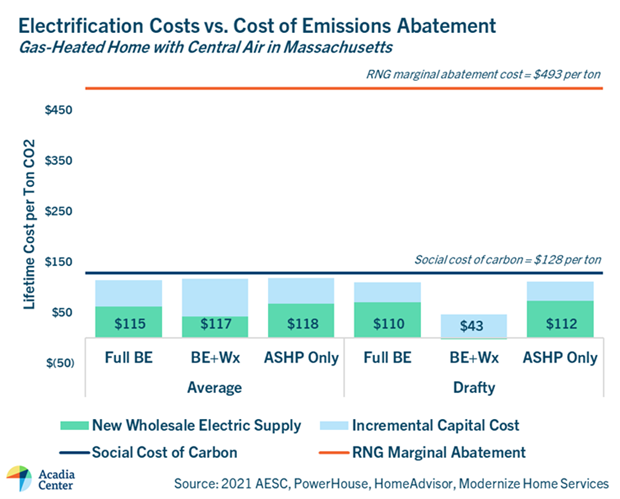
The cost of electrification—i.e. the cost difference between electrification and business-as-usual fossil fuel equipment, plus the cost of new electricity supply—is lower than the cost of emissions to society, and significantly lower than the cost of abating the same amount of CO2 using biogas (RNG).
BE = beneficial electrification
Wx = weatherization
ASHP = air-source heat pump
Average = a home with average building shell efficiency
Drafty = a home with poor building shell efficiency
Using clean, efficient heat pumps to satisfy the Commonwealth’s heating needs is, as the 2050 Roadmap acknowledges, the most cost-effective and the easiest-to-deploy strategy for decarbonizing buildings.[7] In fact, Acadia Center analysis shows that gas-to-heat-pump conversions are cheaper for society than doing nothing: per ton of carbon abated, the cost of whole-home electrification in a gas-heated home is less than the cost of future property and infrastructure damage due to the impacts of climate change—a metric known as the “social cost of carbon.”
Electrification Is The Answer
Energy bill and emissions impacts can vary widely between buildings, depending on their location and their building shell efficiency. Regardless of these variations, whole-building electrification reduces emissions substantially and, in many cases, reduces annual energy costs as well. Combining properly-installed heat pumps with common-sense weatherization measures like insulation and air sealing can reduce bills even further while improving comfort and health.
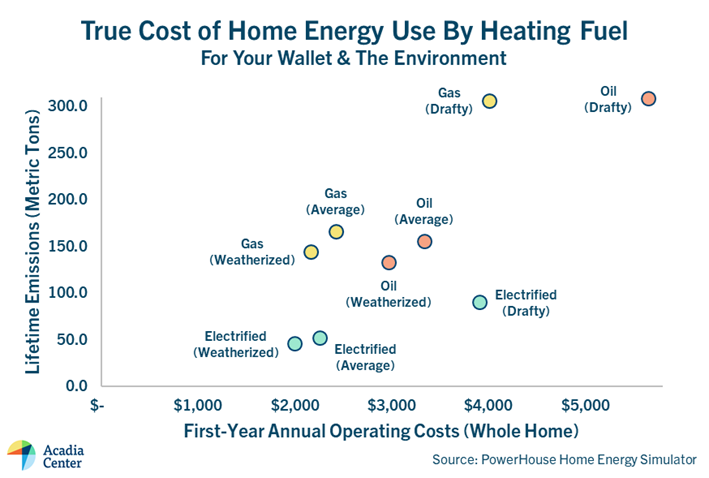
The Mass Save 2022-2024 Three-Year Plan is set to “fundamentally transform”[8] programs to accommodate more building electrification, better equity outcomes, and more investment in workforce development. As a result, robust financial assistance will hopefully be available to any home or business owner who chooses to convert to heat pumps.
Conclusion
The Commission on Clean Heat is the Commonwealth’s best chance to meaningfully address its worsening overreliance on natural gas. It is essential that the Commission seize this priceless opportunity. State agencies, Massachusetts residents, contractors, and industry actors must come together around policies that dramatically reduce emissions from buildings while improving equity and health outcomes. Acadia Center is looking forward to working with Executive Office of Energy and Environmental Affairs and the members of the Commission to promote policies and programs that achieve these goals.
Footnotes
[1] U.S. Energy Information Administration. Residential Energy Consumption Survey (RECS) and Commercial Buildings Energy Consumption Survey (CBECS). RECS: https://www.eia.gov/consumption/residential/ ; CBECS: https://www.eia.gov/consumption/commercial/
[2] HUD Survey of Construction (SOC): Annual Characteristics of New Housing. The median percentage of all housing units built in the Northeast between 2015 and 2020 that heat with gas is 92%. Data files are available at https://www.census.gov/construction/chars/
[3] IPCC Fifth Assessment Report (AR5), 2014. Summary: https://www.ghgprotocol.org/sites/default/files/ghgp/Global-Warming-Potential-Values%20%28Feb%2016%202016%29_1.pdf
[4] Massachusetts Interim Clean Energy and Climate Plan for 2030. December 30, 2020. Page 29. https://www.mass.gov/doc/interim-clean-energy-and-climate-plan-for-2030-december-30-2020/download
[5] Knoema Commodities Data Hub. See: Natural Gas Henry Hub Spot Price, Annual & Monthly; U.S. Natural Gas Futures Closing Price, Daily; EIA Long-Term Natural Gas Price Projection, Henry Hub. https://knoema.com/infographics/ncszerf/natural-gas-price-forecast-2021-2022-and-long-term-to-2050
[6] Jonathan J. Buonocore et al. “A decade of the U.S. energy mix transitioning away from coal: historical reconstruction of the reductions in the public health burden of energy.” Environmental Research Letters: Volume 16, Number 5. May 2021. https://iopscience.iop.org/article/10.1088/1748-9326/abe74c
[7] Massachusetts 2050 Decarbonization Roadmap. December 2020. Page 22. https://www.mass.gov/doc/ma-2050-decarbonization-roadmap/download
[8] Mass Save Program Administrators. “PA Update on 2022-2024 Three Year Plan.” Presented to the Massachusetts Energy Efficiency Advisory Council on September 22, 2021. https://ma-eeac.org/wp-content/uploads/9.22.21-EEAC-3YP-Presenation_FINAL.pdf



















